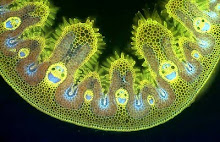About 20 years ago a South Africa botanist gave me a few seeds of this strange succulent, Cyphostemma juttae, which grows in rocky, arid parts of Namibia. It has taken all that time for the seedling to reach this size - about 70 cm. tall - on my windowledge and since it can grow to 2.5 metres tall in the wild it's still got some way to go, although it's under less than ideal conditions, in a flower pot.. Every winter it sheds those succulent leaves completely, leaving only the swollen stem - known botanically as a caudex - then regrows leaves in late spring. It first flowered about five years ago, but this is the first year that the flowers have produced fruits.
The stem constantly sloughs off layers of papery epidermis, which I suspect might have some role to play in reflecting intense sunlight.
The thick, lobed succulent leaves have a saw-tooth margin and each leaf lobe is about 15cm. long.
These small, glassy beads appear on the underside of the leaves, soon after they've fully expanded.
I've yet to discover whether they are crystalline sugar or resin - I suspect they are the latter.
One of the most remarkable aspects of the plant is that it is in the grape family and is commonly known as the Namibian grape or tree grape. You'd never suspect that until you take a look at the fruits, which turn purple when they ripen, but unlike the edible grape they are poisonous.











.jpg)














